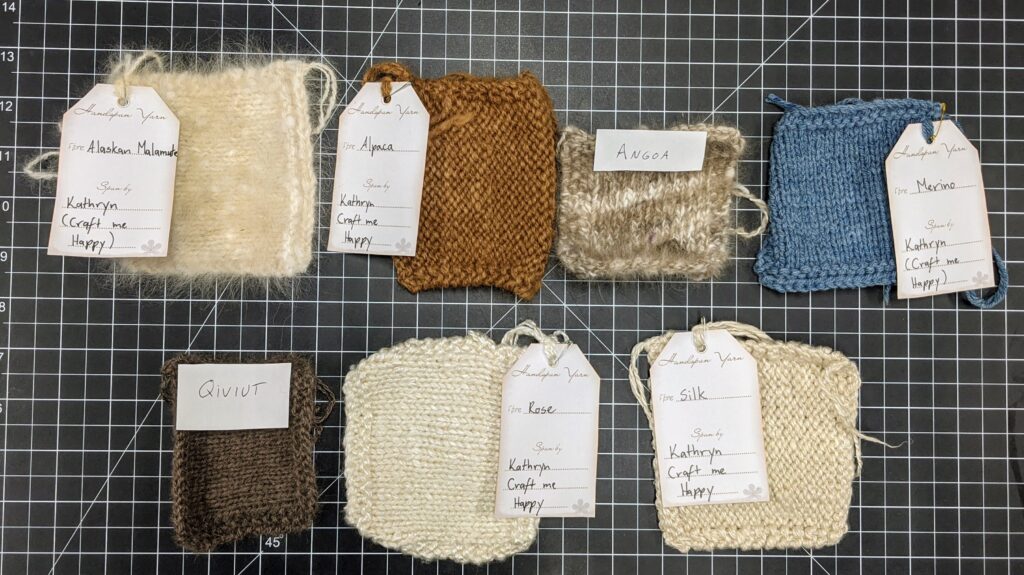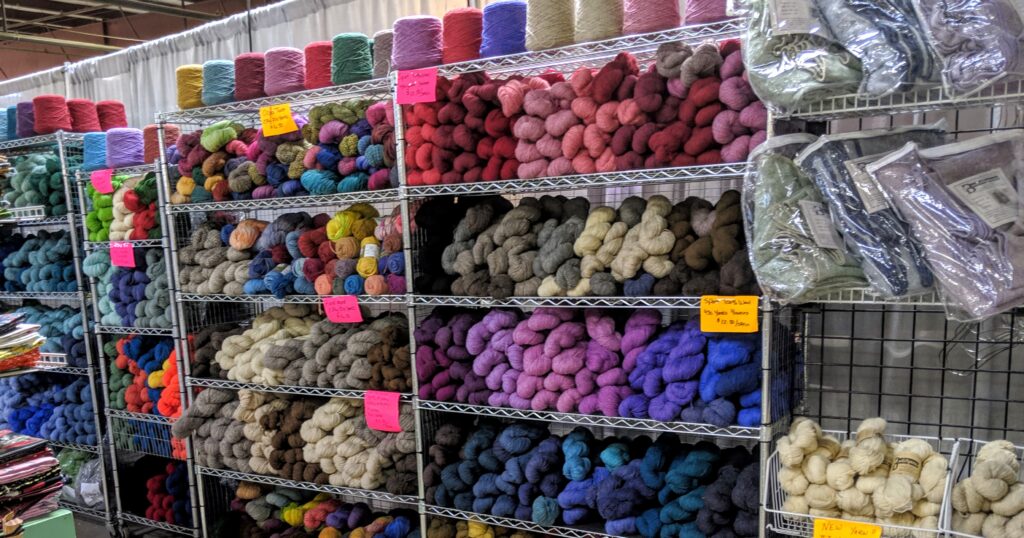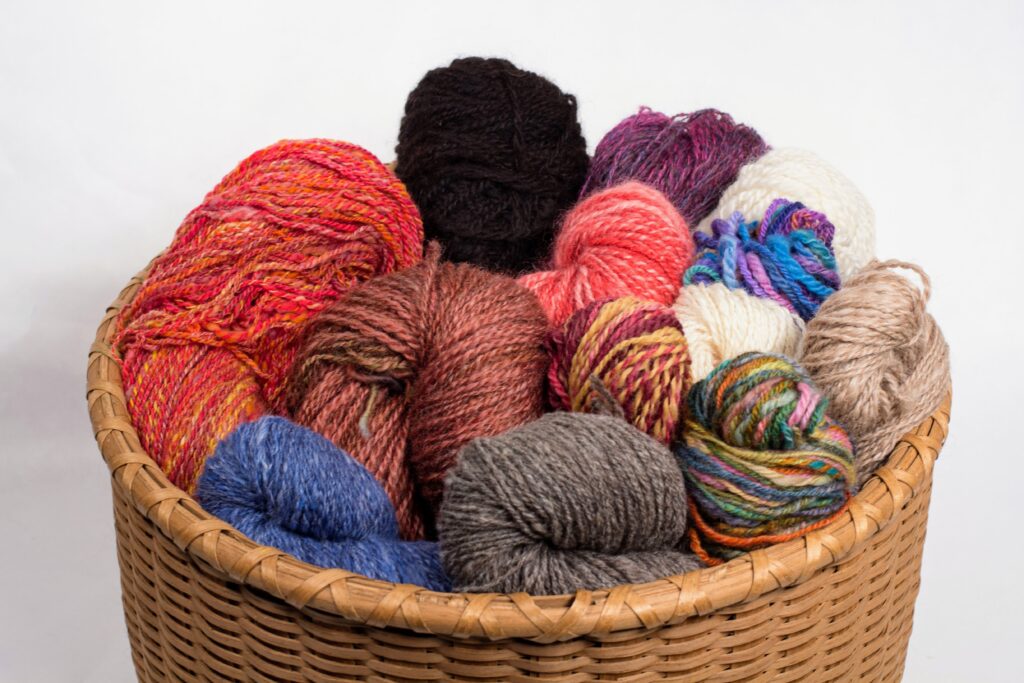If you enjoy a fiber craft like knitting, spinning, crocheting, or weaving; then this article is for you. The reason measuring micron count matters is because micron count can be a good approximation for softness. A smaller micron count means the fibers are thinner and that often leads to a softer yarn.
If you can’t feel the yarn because you are buying it online, then micron count is a great way to get an estimate of yarn softness. Different people will have different meanings for soft. An online review saying the wool is “super soft” doesn’t help you understand how soft yarn really is. However, if you say the yarn is 15 micron Merino that will help a lot if you have been looking at micron count for awhile. A lot of yarn doesn’t report the micron count, but my hope is with this article will help with that. I’d like to see more people start reporting the micron count in online reviews which will help make more informed yarn purchases.
By the way, I’m certainly not trying to say everyone should buy all their yarn online. If you have a local yarn shop or fiber festival I encourage you to support them. Feeling yarn in person is always better than trying estimate the feel from photos and reviews. However, the reality is a lot of fiber lovers buy some of their yarn/rovings online these days and I’d like to make the process better with this article.

Background Information
One of the important measurements when looking at wool and other fibers is it’s micron count. Micron (or micrometer) is the measurement for measuring the diameter of a single fiber. For example Merino fleece will contain fibers with diameters as low as 10 microns or thicker fibers of maybe 25 micron diameter. A micron is one millionth of a meter or one thousandth of a millimeter.
Certified fiber labs can accurately measure samples when you want official micron counts. There are two reasons a lab typically does this measurement. First the tools they use to analyze the fiber require some training to use properly and if not used properly you’ll get the wrong results. Secondly, the tools they use are expensive. One of the typical tools is the OFDA2000 which typically costs around $60,000-$75,000. A newer tool called a FiberLux costs a little over $2,000. My general understanding from what I’ve read is the OFDA2000 is basically the standard way of measuring fiber and the verdict is still out if the newer FiberLux is accurate enough to replace it in some use cases (this was written in early 2021). Here is an article with more options if you are interested in more details about various ways micron counts are measured.

Measuring Yarn Micron Count Yourself
Before these automated machines people would look under microscopes to manually measure fiber. This is interesting option, but requires a lot of a lot of time and training to learn how to measure fibers consistently and accurately under a microscope. I did some research and found a common way to measure human fiber (we call it hair) is using laser diffraction and interference. This sounds complicated, but is actually pretty straight forward. You basically shine a laser pointer at a hair and then due to the how light works it will create a pattern of bright and dark wave pattern on the wall. You know the distance from the hair to the wall, the distance between these light/dark pattern on the wall, and the wavelength of your laser pointer so you can calculate the diameter of the hair with this equation.
Note for those not wanting to do the math I added a calculator below on this page that does it for you.
hair_diameter = (wavelength of laser) / (distance_between_light_dark_pattern / distace_to_wall)
For example when I measured one of my hairs, I was using a red laser with a wavelength of 650nm. The distance to the wall was 651 cm. The distance between the light/dark pattern was 4.8 cm. Using the equation above gave me a hair diameter of 88,000 nm, or 88 micrometers. If your laser pointer doesn’t list its wavelength you can use 650nm for red lasers and 532nm for green lasers.
Another simpler method is is to use a Micrometer. That link is the one I used which has a 0.001mm resolution which is a 1 micrometer resolution. I did a lot of testing with it and it was quite consistent, but it was consistently less than the light diffraction method above. I think the reason for this is using a Micrometer can squish the yarn. So to get accurate measurements you should either use the light diffraction method or practice with the micrometer on known fibers until you get a good feel for how much pressure to use without squishing the fiber. I talk about this more in the video below.
So those are the two methods I used to get fiber diameter and each one cost me under $40. I created the video below that goes into more detail on these two methods of measuring a fiber’s micron count.
Primitive breeds tend to be far less consistent in micron count, both between animals and even within an individual fleece, so for those it’s especially important to take measurements from several areas if you want a decent average, or to grade the fleece well. Modern wool sheep are bred for fiber consistency, so for them it’s less of a big deal, though you’ll likely still find a bit of difference between the neck (finer) and the britch (coarser).
Fiber Micron Calculator
Measuring Fiber at a Wool Testing Lab
I did some searching with some labs that test fiber samples. The best two options I found were New Zealand Wool Testing Authority (NZWTA) and Montana Wool Lab. The online documentation for NZWTA is much better so if you want to do more research online I’d recommend their website. That said I have contacted the Montana Wool Lab because shipping them samples is easier for me since they are located in the USA. Contacting the Montana Wool Lab by email ([email protected]) and phone (406-994-2100) worked for me.
When I emailed Montana Wool Lab they gave me this submission form and this document that explains report you get on your fiber samples. You can see their prices as of March 2021 on the submission form linked above, and they seemed very reasonable to me. Example each wool sample I want tested would cost me only $3.
I found their fiber report document very informative. It explains they don’t just measure the one fiber, or a few fibers. They measure the diameter of many fibers and provide you with an average fiber diameter plus a standard deviation from that average value. With that information you’ll know a lot more about the fiber than measuring just a few fibers like my DIY approaches in the previous section. They also include a comfort factor which is the percentage of fibers that are 30 microns in diameter or less because this has been found to be a diameter that can cause skin irritation.
Judith MacKenzie says that a mix of high and low micron counts in a yarn is what causes the itchy feeling, more than simply high micron fibers alone. I haven’t verified this myself, but Judith is well known in this field so I want to share this.
I’m planning to send in some samples and get some reports from Montana Wool Lab in the future. I haven’t done it yet, but will report back when I have results from them.

Help spread the word about micron count and share this post with a friend.
I’d like to thank Vampy who reviewed an early draft of this blog post and provided some great feedback.

Maurice, thanks for this very interesting article! I might try that laser method out. But I was wondering if I could use my stereo microscope and some kind of reticle (in the eyepiece measuring scale) to arrive at an average thickness in microns. The scope will focus to about 60X, so I would think it was getting into the 10’s of microns range in what you could see…just wondering. I would suspect that you could learn a lot about specific fibers by actually looking at them closely.
I’ve actually read about microscope reticle’s since I wrote this article. I think those would be a good way to it. I believe that used to be the method used before there were electronic machines that have been calibrated to do it more quickly.
WOW! I’m a spinner and I’m not technical in the least. I am self taught as I live in a rural area so reading articles like this makes me so excited when I start to understand how knowing micron information when buying a fleece can be very helpful in the approach to how I spin it. I got on this sight as my little rural spinning group is doing a breed study and we’ve each taken an animal to represent, I’m working on Huacaya and Suri Alpaca. As I’m writing up what I will present to the group I started reading about microns and felt I needed to understand more about them which led me to your site. Thank you for such a great explanation and thank you for those who added in the comments. I have a whole new way of looking at my fiber to spin now and I’m super excited.
I don’t think that would be an appropriate system for quantifying the softness of yarn. Micron measurements provide useful information about fibers or fleeces. In general they can possibly give a rough idea of the *potential* of the yarn made from the fiber in question.
However, it can’t be used to quantify the softness of the *finished yarn*. Too many other elements have more of an effect. DIY spinners are very aware that beginners can spin the finest merino into a coarse rope. Double-coated fleeces can be fine, but if the two different lengths are spun together worsted, the longer guard hairs will poke out and prickle. Commercially, treatments like Optim can dramatically change the fiber’s properties.
Try it for yourself. World of Wool offers merino roving by specific micron count. Buy a pound of 21-micron merino and send one ounce out to 16 different spinners of all different philosophies, backgrounds, and experience levels. The yarns you’ll get back will all be 21-micron, but the feel will be extremely different, not just in terms of weight or airiness, but also in terms of perceived softness.
In conclusion: micron counts are useful when you’re buying fiber or a fleece, but not very informative when you’re buying yarn. Which is why they’re used when selling fiber or a fleece, but not when selling yarn.
I completely agree that micron count isn’t the only factor that matters for softness. This is why I started out by saying feeling the softness in person is the best method if you can do it. However, I do think it matters some with yarn and I couldn’t think of a single factor that would be more important or easier to measure on yarn.
I didn’t want to make a complex article explaining all the different factors such as chemicals used in washing, method of carding, twist, worsted/woolen, and then fiber blending.
I do think you bring up a valid point and hopefully people reading this article will read your comment because I think it has a valid standpoint. However, I think having the micron count of yarn will help determine the softness if you can’t touch it yourself.
Micron count isn’t always provided for top/roving/sliver, though, and I find that frustrating. I’m likely to include home tested micron counts in reviews of roving, and I’m very grateful to MR for the video and explanation here!
I agree, micron counts aren’t always helpful in determining softness of yarn…
… but if I look at a picture of yarn and see it is a single that has a loose twist and regularly smooth even thickness, it will give me a far better guess at its softness as compared to other loose twist even singles… the same goes for tighter twist multi-plies compared to other yarns with similar attributes.
Great observation, though. Thanks for the perspectives that helped me think through how to describe more in my reviews (which helps me maintain my reviewer ranking)!
Thanks for this. I actually initially wrote this for rovings and then changed it to yarn because I thought it would apply to more people. I totally agree that this applies to rovings too.